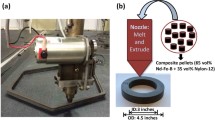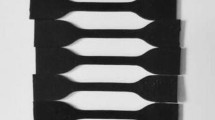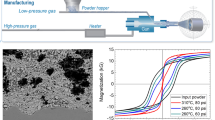Abstract
The goal of this research is to fabricate near-net-shape isotropic (Nd)2Fe14B-based (NdFeB) bonded magnets using a three dimensional printing process to compete with conventional injection molding techniques used for bonded magnets. Additive manufacturing minimizes the waste of critical materials and allows for the creation of complex shapes and sizes. The binder jetting process works similarly to an inkjet printer. A print-head passes over a bed of NdFeB powder and deposits a polymer binding agent to bind the layer of particles together. The bound powder is then coated with another layer of powder, building the desired shape in successive layers of bonded powder. Upon completion, the green part and surrounding powders are placed in an oven at temperatures between 100°C and 150°C for 4–6 h to cure the binder. After curing, the excess powder can be brushed away to reveal the completed “green” part. Green magnet parts were then infiltrated with a clear urethane resin to achieve the measured density of the magnet of 3.47 g/cm3 close to 46% relative to the NdFeB single crystal density of 7.6 g/cm3. Magnetic measurements indicate that there is no degradation in the magnetic properties. This study provides a new pathway for preparing near-net-shape bonded magnets for various magnetic applications.





Similar content being viewed by others
References
K.J. Strnat, Proceedings of the IEEE 78, 923 (1990).
D. Bauer, D. Diamond, J. Li, D. Sandalow, P. Telleen, and B. Wanner, USDOE Critical Materials Strategy, 1 (2010).
U. S. Department of Energy—Critical Materials Strategy (2011) December Report.
S. Hirosawa, Y. Matsuura, H. Yamamoto, S. Fujimura, and M. Sagawa, J. Appl. Phys. 59, 873 (1986).
E.B. Boltich, E. Oswald, M.Q. Huang, S. Hirosawa, W.E. Wallace, and E. Burzo, J. Appl. Phys. 57, 4106 (1985).
H. Ucar, I.C. Nlebedim, M.P. Paranthaman, and R.W. McCallum, J. Appl. Phys. 116, 233901 (2014).
S.M. Gaytan, M.A. Cadena, H. Karim, D. Delfin, Y. Lin, D. Espalin, E. MacDonald, and R.B. Wicker, Ceram. Int. 41, 6610 (2015).
J. Ormerod and S. Constantinides, J. Appl. Phys. 81, 4816 (1997).
N. Hamada, C. Mishima, H. Mitarai, and Y. Honkura, IEEE Trans. Magn. 39, 2953 (2003).
Hamada, K. Noguchi, C. Mishima, and Y. Honkura, “Development of Anisotropic Bonded Magnet with Heat Resistance”, Magnetic Conference, Intermag Asia 2005, Digests of the IEEE International, pp. 941–942 (2005).
J.J. Croat, J. Appl. Phys. 81, 4804 (1997).
S. Sugimoto, J. Phys. D Appl. Phys. 44, 064001 (2011).
D. Brown, B.M. Ma, and Z. Chen, J. Mag. Mater. 248, 432 (2002).
D.N. Brown, Z. Wu, F. He, D.J. Miller, and J.W. Herchenroeder, J. Phys. Cond. Mat. 26, 064202 (2014).
N. Hamada, K. Noguchi, C. Mishima, and Y. Honkura, IEEE Trans. Magn. 41, 3847 (2005).
D.N. Brown, Z. Chen, P. Guschl, and P. Campbell, J. Mag. Mater. 303, 371 (2006).
C.B. Williams, F. Mistree, and D.W. Rosen, J. Mech. Des. 133, 121002 (2011).
G. Manogharan, M. Kioko, and C. Linkous, JOM 67, 660 (2015).
Acknowledgement
This work was supported in part by the Critical Material Institute, an Energy Innovation Hub funded by the U.S. Department of Energy, Office of Energy Efficiency and Renewable Energy, Advanced Manufacturing Office. The research on the printing was supported by the U.S. Department of Energy, Office of Science, Office of Workforce Development for Teachers and Scientists (WDTS) under the Science Undergraduate Laboratory Internship program. Access to the MDF facilities and use of additive instrument time and labor are supported by the MDF Tech Collaborations between ORNL and Magnet Applications Inc. and Tru-Design LLC.
Author information
Authors and Affiliations
Corresponding author
Rights and permissions
About this article
Cite this article
Paranthaman, M.P., Shafer, C.S., Elliott, A.M. et al. Binder Jetting: A Novel NdFeB Bonded Magnet Fabrication Process. JOM 68, 1978–1982 (2016). https://doi.org/10.1007/s11837-016-1883-4
Received:
Accepted:
Published:
Issue Date:
DOI: https://doi.org/10.1007/s11837-016-1883-4




